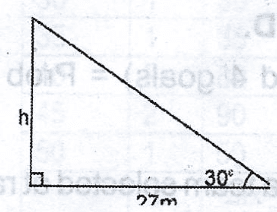27m
13.5 √3m
13.5 √2m
9√3m
Correct answer is D

From the diagram,
tan 30o = h27
h = 27 tan 30o
= 27 x 1√3
= 27√3 x √3√3
= 27√33
= 9√3m
Expression 0.612 in the form xy, where x and y are integers and y ≠ 0
153250
68111
61100
2133
Correct answer is A
0.612 = 0.6121 x 10001000
= 6121000
= 153250
If x : y = 14:38 and y : z = 13:49, find x : z
2:3
3:4
3:8
1:2
Correct answer is D
xy = 14÷38 = 14×83 = 23
yz = 13÷49 = 13×94 = 34
But,
x = 25T1, y = 35T1
y = 37T2, z = 47T2
Using y = y
35T1 = x = 37T2
T1T2 = 37 x 53 = 1521
T1=15 and T2=21
Thus , x = 25 x 15 = 6
y = 35 x 15 = 9
y = 37 x 21 = 9
z = 47 x 21 = 12
Hence; x : z = 6 : 12
= 1 : 2
Find the inter-quartile range of 1, 3, 4, 5, 8, 9, 10, 11, 12, 14, 16
6
7
8
9
Correct answer is C
Q1=14 (N + 1)th
14×12th no.
= 3rd no (≅ 4)
Q3=34 (N + 1)th
= 34 x 12th no.
= 9th no. (≅ 12)
Hence, interquartile range
= Q3−Q1
= 12 - 4
= 8
If 3xo 4(mod 5), find the least value of x
1
2
3
4
Correct answer is C
3x ≡ 4(mod 5)
In modulo 5, multiples of 5 that give solution to the given equation are 5, 20, 35, 50,... but 5 will yield the leaast value of x.
Thus; 3x = 4 + 5 = 9
x = 93
x = 3
WAEC Subjects
Aptitude Tests